First, a brief history of automotive HVAC systems.
For many years even a heater was optional on most US-built cars; mass-luxury automaker Packard was the first to sell it as a factory installed option for their 1940 models, and Chrysler made it optional on some cars for 1942, but most people had to turn to the aftermarket for years to come. Even in 1948, the upscale Chrysler brand DeSoto made heaters optional; dealers could install Mopar heaters and defrosters if the buyer regretted getting a car without one.

The first large-scale Chrysler car air conditioners, mounted in the trunk and using R22 refrigerant, arrived for higher-end 1953 models; and by the late 1950s, virtually all US makes had some sort of factory air conditioning. Early units had a separate heater and air conditioner, sometimes with some shared controls, sometimes with separate controls. Gradually, over the years, the systems were integrated.

Starting with the 1957 models, Chrysler Corporation cars used a compact setup with the evaporator and heater core coupled in the center of the firewall; the blower was under the hood, and only the the distribution ductwork was inside the car. These brought in more fresh air than GM or Ford systems, and had flush-mounted cowl intakes while competitors used scoops. The condensor was in front of the radiator to get fresh air without blocking engine cooling; and the coolant was now R12, as it would be until the 1995 Neon was the first Mopar to use R134a.
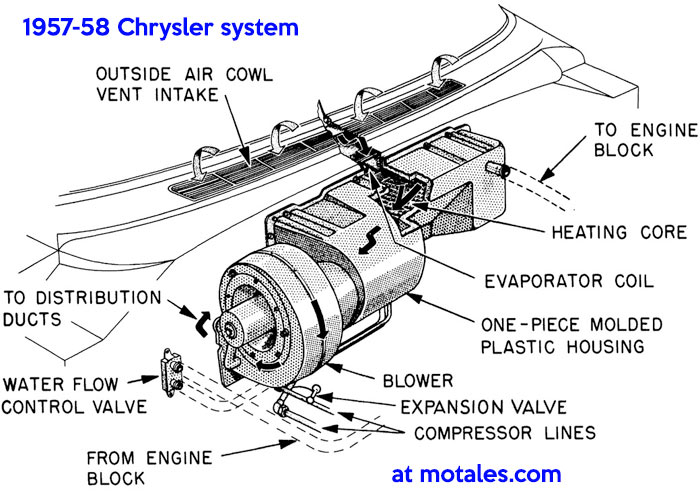
When the driver moved the control, a cable adjusted a thermal valve to change the antifreeze flow in the heater core; on our 1959 DeSoto, for example, any changes took time as the coolant in the heater core took time to change and the temperature-controlling flow valve would increase or decrease the flow as it stabilized. Ford and GM used a blend door system insterad; all the air went through the AC evaporator, then all, a portion, or none of the air went through the heater core to be warmed. As a result, changing the setting brought immediate results.
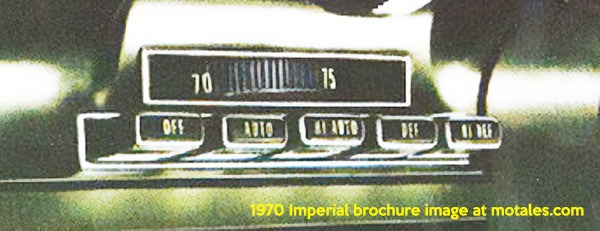
In 1964, Cadillac surprised everyone with their “Comfort Control” automatic climate control system, which gradually trickled down the GM lines. Ford launched theirs on 1966 Lincoln Continentals. GM and Ford used vacuum servo systems; GM had one servo for the blend door with fan speed contacts on it to adjust fan speed, while Ford used two servos, one for the blend door and one for fan speed.
Chrysler followed on the 1967 Imperial, with a single-year design somewhat similar to GM’s. It had a transducer and one survo to move the vacuum control valve with another to control the heat temperature. This was dubbed ATC I. Just one year later, they launched the ATC II system on the 1968 Chrysler and Imperial, marketed as “AutoTemp”—a play on their AirTemp house/business air conditioning division. This setup was rather different from those of GM and Ford; it used a large water flow control valve under the hood, on the right inner fender, similar to its manual system, due to Chrysler’s sandwiched A/C evaporator and heater core layout. It’s possible they had licensed the prior year’s system, or perhaps felt this was a more elegant design.

In 1972, Chrysler made some changes to the system and designated it AutoTemp II. The main change was putting most of the system into the cabin, like Ford and GM. The servo assembly also changed fan speed from Lo, M1, M2, M3 for heat and Lo, M1, M2, M3, M4 for AC in Lo-Auto and M2, M3, Hi for heat and M2, M3, M4, Hi for AC on Hi-Auto. On Lo-DEF it used the same fan speed as Hi-Auto, on Hi-DEF the system went to Hi fan and full heat immediately.
The 1974-78 cars had a similar setup, but a servo motor controlled the air blend doors rather than using thermal valves in the heater core.
With the shift to front wheel drive (FWD), the system disappeared from Chrysler and Imperial. GM had already dropped down to a semi-automatic system in its 1977 cars.
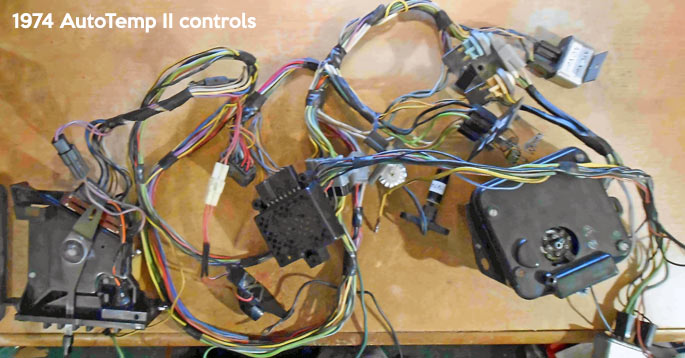
Moving the temperature lever in the bench-test setup above causes the servo to react to increase heat or cooling; warming the in-car sensor causes the servo to try to bring cold air. When the “ignition” power is removed, the servo parks on either the cold or warm side.
In 1982, the Chrysler LeBaron nameplate moved to a Plymouth Reliant/Dodge Aries-based car also sold as a Dodge 400. These were referred to as “Super Ks,” as they had extra sound insulation, power windows and locks, extra courtesy lights, and overall better trim. One of the missing options was an ATC system; Chrysler went without automatic temperature control until the 1986 cars, when they added a semi-automatic unit to premium lines (see below).
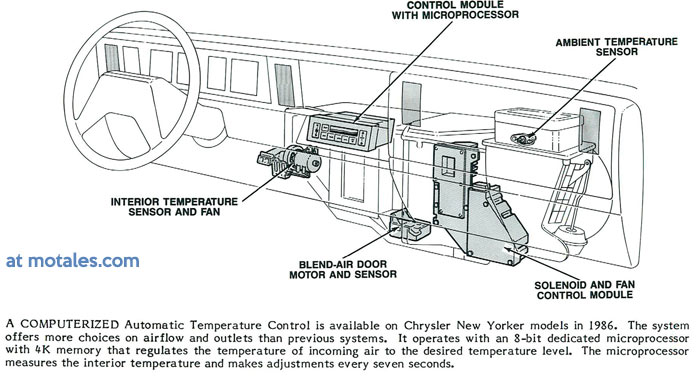
Starting in 1991, the vacuum module was dropped and two additional servo motors were added, one for fresh or recirculated air and one for mode (face/dash vent, heat/floor, and defrost). This system was used through 1993.
Newer systems, using more electronics and multiple zones, quickly became common as time went on and the costs fell. Minivans and then SUVs and crossovers typically had three zones while sedans, pickups, and such typically had one for the driver and one for the passenger. In higher end units, the rear temperature can either be controlled from the front or the center seats (minivans had an override so children couldn't play with it too much). Rear vents are usually handled by single floor level duct (Ford has theirs under the left center seat in the Flex; many others use the passenger seat). The 2009 Ford Flex also has, between the center seats, a refrigerator/freezer center console, echoing the old Dodge Caliber’s refrigerated glove compartment/soda coolers.

Unlike the AutoTemp II system, the 1986 automatic temperature control used a power transistor or silicon controlled rectifier (SCR) as the fan-speed controller, rather than a servo. They did use a servo motor for the blend door, keeping vacuum controls for vent and recirculation/fresh air. The HVAC case had a large opening cut in its back side to cool the fan control electronics; the fan control and a bank of 5 solenoid valves and 2 relays were atached to the HVAC casing. This was either a semi or fully automatic system through 1990.
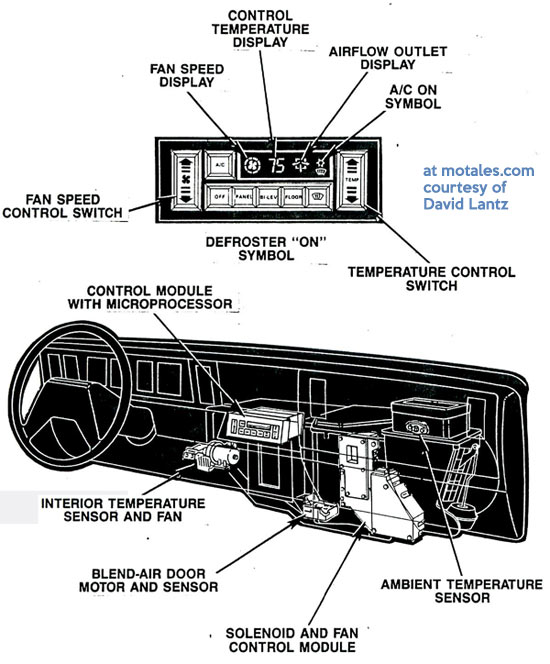
The owner selected the fan speed and mode; the only truly automatic feature was the blend door actuator. Otherwise, it used the same vacuum actuators as the manual system.
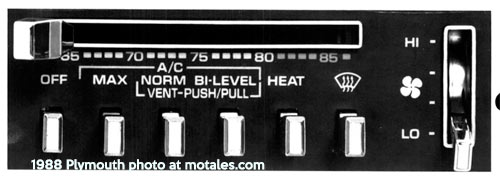
The control panel (above) was easier to use in the 1988 M-bodies (Gran Fury, LeBaron, Diplomat) combined a slider for temperature with a fan switch and vent buttons. Again, this was a semiautomatic system, with the driver setting fan speed and vents.
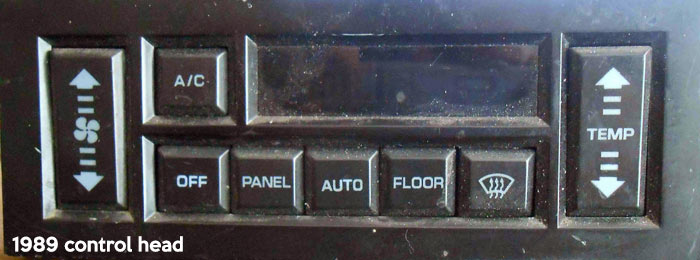
The 1989 system was similar to the 1987 setup, except the “Auto” button changed the vent setting (dashboard “face” vents, floor vents, or defroster) as needed. For 1991, Chrysler adopted Euro-style icons and switched to using a temperature sensor in the coldest part of the evaporator to avoid freeze-ups and achieve higher performance. This let the system keep the temperature to within around 1°-2° of freezing, regardless of whether the vehicle had automatic or manual controls, and was a major improvement over past systems.
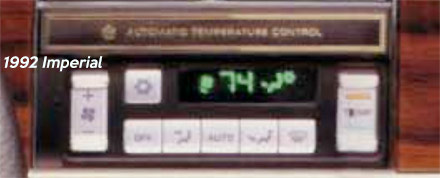
Imperial automatic controls—also shown in the diagram below.
The 1991-93 system finally eliminated vacuum controls in favor of three servo motors—one for blend (variable from cold to hot), one for fresh air or recirculation, and one for mode (center for floor, one extreme for dashboard, the other extreme for defrost). Overtravel springs allowed the servo to rotate in the opposite direction until it stalled, at which point the control head removed the power; the fresh air/recirculation servo simply ran one way or the other until it stalled. The control head had a common lead and three dedicated leads to the servos. The head set + or - on the common and then the servo lead to the opposite polarity. The blend had a 100% feedback; the mode had a center position sense. Fan speeds were stepless, using an SCR or power transistor.
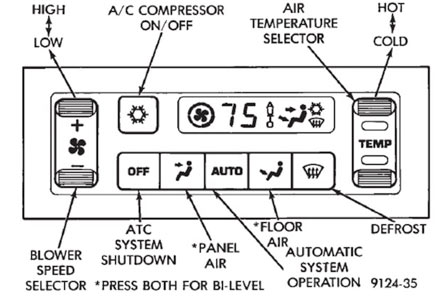
An aspirator sensed in-car temperatures; the ambient air sensor was in the inlet to the fan inlet, so it picked up the air temperature coming into the car. 1986-87 head units will probably work on newer through 1990 electric and vacuum modules, but not on the 1991 systems.
Mercedes-Benz used a modified Chrysler system from 1978 to 1981 (with a small running change in July 1978). They were modified somewhat with a bi-level mode, an extra vacuum switch, and three solenoid valves; the air inlet door has two vacuum servos, one for the 20/80 fresh air/recirculated air system and one for full fresh air vs full recirculation. There is also a two-stage defroster acutator, a floor (heat) actuator, and a center dash flow actuator. The compressor is controlled by a separate rocker switch.
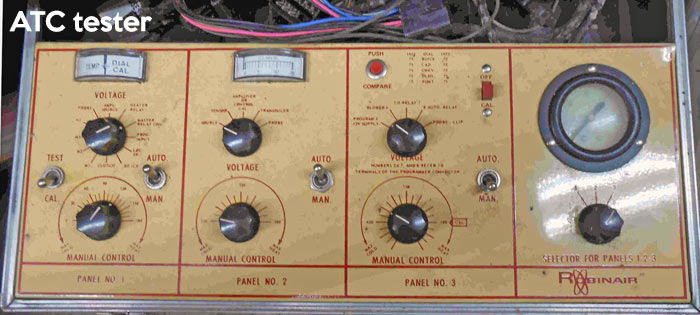
I repaired a number of these when working at Tysinger Motors, using this Robinair tester; I spliced Mercedes service plugs from their parts department onto the Chrysler test cable to make it work with their systems.
Copyright © 2021-2025 Zatz LLC • Chrysler / Mopar car stories and history.
YouTube • Editorial Guidelines • Videos
Tailfins Archive • MoTales on BlueSky